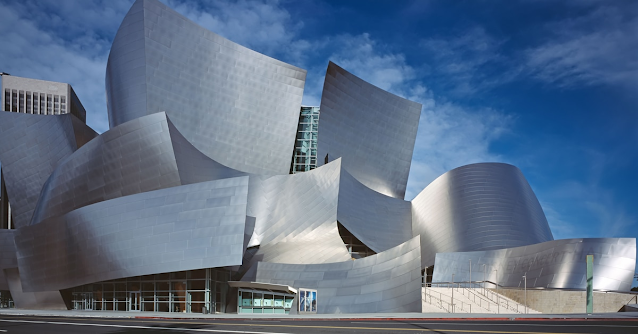Listening to Buildings
 |
| Frank Gehry: Disney Concert Hall; Los Angeles, 2003. (street-level view) |
Deconstructivism is one of the 20th/21st century's most influential architecture movements. Emerging in the early 1980s, deconstructivism combines ideas from the deconstruction theory of philosophy with the name of the Soviet architecture style known as constructivism.
Deconstructivism is defined as a breaking down, or demolishing of, a constructed structure. Deconstructivism is not a new architecture style; nor is it an avant-garde movement against architecture. It does not follow rules or require specific aesthetics; it is not a rebellion. It is the unleashing of infinite possibilities of playing around with forms and volumes.
Merriam-Webster offers this definition: an architectural movement or style influenced by deconstruction that encourages radical freedom of form and the open manifestation of complexity in a building rather than strict attention to functional concerns and conventional design elements (such as right angles or grids).
 |
| Frank Gehry: Disney Concert Hall; Los Angeles (aerial view) |
There are other deconstructionist architects besides Frank Gehry, but I'll be using examples of his work. He is certainly one of my favorite architects and for me, embodies deconstructivism; however, I don't know if Mr. Gehry considers himself a deconstructionist.
One of the many things I like about architectural deconstructivism is that it completely redefines the definition of a building. It transforms something previously rectilinear into something sculptural. Architectural deconstructivism eliminates right angles, bilateral asymmetry, and predictable design patterns. For me, it is like visual poetry.
 |
| Frank Gehry: Guggenheim Museum; Bilbao, Spain. 1997. |
I've spent some time inside and around the Disney Concert Hall in Los Angeles. Architecture like this practically re-aligns the neurons in my brain. It causes me to think of how this kind of concept, these shapes, this poetry, could be applied to music.
If so, what would this music sound like? If shape could be translated or transposed directly into sound, what would these buildings sound like? This concept is so palpable to me that I can inwardly hear things when seeing these structures.
Like architecture, music consists of forms and shapes. I often think of how to re-shape some of these forms, or create new ones. What would the new shapes look like? How can some of the familiar patterns be eliminated? Can the tenets and theories of deconstructivism apply to music? I think they can.
As of this writing, this is a thought process that I've had for several years. I don't know if deconstructivism has taken root in any of my music. I've always been drawn to fragmented melodic lines and dense cluster chords and harmonic structures. Perhaps this is a kind of deconstructivism, or maybe it's some deconstructivist tendencies creeping into what I do. I'm not sure.
I'm not trying to take away from the existing forms and architecture in music. I greatly admire them and of course I utilize it all; how could I not?
But what else is possible with it? Is deconstructivism one of many tools and directions to be used to take music to its next level of growth? I have no concrete answers right now. But I am thinking about it. Extensively.
-kk
 |
| Frank Gehry: Guggenheim Museum; Bilbao, Spain. (exterior detail) |


Comments
Post a Comment